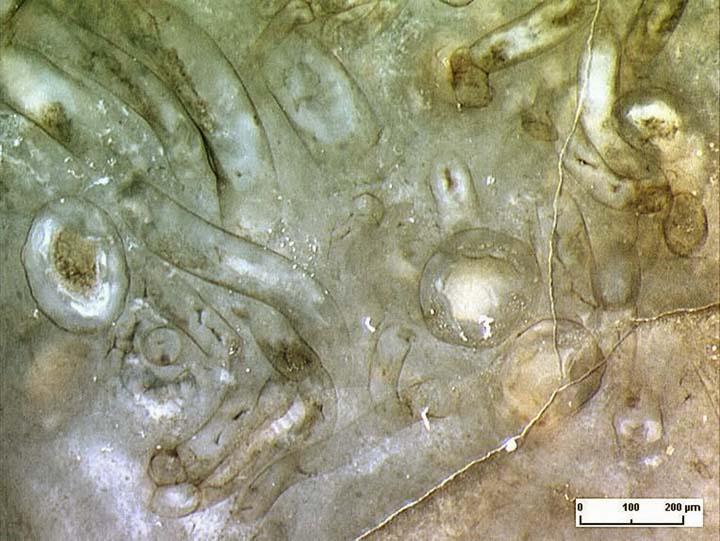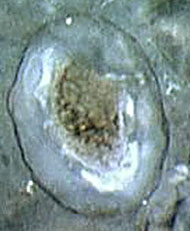Devonian alga mimicking Coleochaete
Any fossil alga resembling Coleochaete
in some way should deserve attention, for two reasons: The small
freshwater alga Coleochaete
is thought to be the closest relative to the earliest land plants, the
ancestors of all extant "higher" plants, and it has never been found as
a fossil.
A Lower Devonian alga of uncommon aspect as seen here shows several
features also seen on an extant species of Coleochaete as
described in detail by Oltmanns
[1]:
(1) branching filaments emerging from a common base attached to a
substrate,
(2) spherical capsules at the end of some branches which may become
cup-like by splitting open,
(3) dark inclusions in the cells, probably the nucleus and a large
elongated chloroplast.


Fig.1:
Devonian alga in Rhynie chert, one specimen on the left branching near
the base, seen attached to a substrate. Width of the picture 2.8mm,
scale bar 0.25mm.
Insert above right: Extant freshwater alga Coleochaete pulvinata
for comparison, same scale. Photographs: H. Sahm. Sample:
Rh2/75.8, found in 2006.
In
this sample, a bunch of filaments connected at their base (Fig.1
left) seems to have been attached to a submerged axis of a
terrestrial plant of the
Rhynie flora which after decay had left a cavity filled with
bluish-white chalcedony only.
What
looks like a partially coated capsule in Fig.1 above might be merely
incidental but the cup-like forms in Fig.1 below right are most
intriguing. Four of them are seen slightly higher magnified in Fig.2.

Fig.2: Devonian alga with objects of cup-like aspect. Same sample as
Fig.1.

Fig.3: Detail of Fig.2: object of cup-like aspect
with polygonal pattern inside.
The
peculiar objects of cup-like aspect are rather smooth on the outside
but the wall of the enclosure seems to bulge inward.
The polygonal pattern seen in one
cup suggests an interpretation as sporogenic tissue as it is known from
the thick-walled "zygote fruits" or sporocarps of Coleochaete.
An interpretation of this fossil as being closely related to Coleochaete,
driven by both wishful thinking and stunning similarities, should be
questioned by weighing the arguments in favour and against.
The
large difference in cell sizes is not relevant in this connection since
sizes can greatly change for various reasons, as, for example, the
widespread phenomenon of polyploidy. The time span of 400 million years
between this fossil and Coleochaete
would not necessarily wipe out old
features, as we know from extant Nitella,
which looks quite similar to
the Lower Devonian Palaeonitella.
(See Rhynie
Chert News 10.)
Hence,
the sporocarp of Coleochaete
could well be homologous to the round
objects seen here.
A contrary argument is based on the similarity between Fig.1 and early
growth stages of Palaeonitella,
which do not yet grow the typical
whorls of branches but more irregular branching near the base. Also it
is known that fungus infection can cause
Palaeonitella
cells to become bloated into globular shape [2]. Hence,
what is seen here could possibly be juvenile Palaeonitella with
deformed cells. Anyway, the polygonal structure in one of the cups
looks like some tissue, which is not compatible with the notion of
a merely bloated cell. So it appears that this fossil remains
enigmatic, and if it really would
turn out to be closely related to Coleochaete,
it could contribute to a better understanding of the origin of land
plants.
Annotation 2015:
Among the numerous reconstructions depicting the various land plant
species found from the Silurian up to the Early Devonian
summarily
called Cooksonia
[3], a few
show cup-like objects strikingly similar to those seen in the above
images. Hence, an interpretation of this plant as a Cooksonia species
would be another option. Considering that this name, in
a phylogenetic sense, is only a vaguely defined
label, it would at least indicate that the present fossil may be
neither close to Palaeonitella nor
to Coleochaete.
The absence of any cellular structure in Cooksonia
reconstructions may be due to the fact that Cooksonia had
always been found as
compressions but never in chert.
Annotation 2019: A short tube found 3cm away, 100Ám across, with blunt
top and several small branches
thereon, seems to indicate that this alga resembled stoneworts when
adult. Also in this sample, there are alga cells bloated into spheres
up to 200Ám, without cup-like aspect. Possibly the cups and the spheres
are of different origin and their common presence in this sample is
merely incidental.
H.-J. Weiss
2012,
2015, 2019, 2020
[1] F. Oltmanns:
Morphologie und Biologie der Algen, Gustav Fischer Verl. Jena 1922.
[2] T.N. Taylor
et al.: Paleobotany. Elsevier 2009. p.102.
[3] H. Steur: steurh.home.xs4all.nl
 |
 |
48 |







